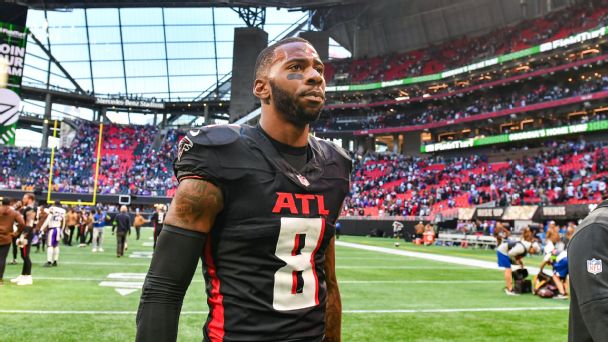
KYLE PITTS BROKE out of the huddle and jogged to just outside the right hash at the Tampa Bay 38-yard line, waiting for quarterback Desmond Ridder to start the play. Pitts broke down the field, cut right and then turned upfield.
Ridder threw a perfect ball, hitting Pitts for a 36-yard touchdown — Pitts’ second of the season and the longest touchdown catch of his career.
The Atlanta Falcons tight end began this play like he has for most of his three seasons: in the slot. He has gained more yards, run more routes and caught more passes out of the slot than anywhere else on the field.
Nicknamed “The Unicorn,” Pitts has the size (6-foot-6, 246 pounds) of a traditional tight end with the speed (he ran an unofficial 4.44-second 40-yard dash at Florida’s pro day in 2021) and skills of a receiver — a combination that made him the No. 4 pick in the 2021 draft, the highest a tight end has ever been selected.
Pitts’ usage is a byproduct of Falcons coach Arthur Smith’s philosophy, which embraces positionless football, as multiple players in Atlanta’s offense are capable of lining up in various places to create mismatches.
“We got a lot of guys that can make plays, and how we want to operate and what we think the best game plan is to deploy those guys and different packages,” Smith said in August. “And they can line up all over the place. I think that’s what makes us unique.”
That Pitts is able to blur positions with his versatility is a positive for the Falcons on game day, but it might create an interesting dynamic this offseason when Atlanta has to decide if it will pick up his fifth-year option.
Whether he is paid as a tight end or a receiver makes a difference of almost $9 million.
Pitts’ fifth-year option as a tight end would be a projected $10.561 million, according to Over The Cap. As a receiver, it would be projected at $19.398 million. Those salaries are elevated because of Pitts’ Pro Bowl appearance and would be fully guaranteed because of the latest collective bargaining agreement.
“He’s a receiver,” Falcons edge rusher Bud Dupree said. “Definitely should be a receiver.”
Pitts told ESPN recently he wasn’t aware of the difference in pay between the fifth-year options. It’s possible Pitts won’t even pursue receiver money. He said he wants to learn more about it, but he also said he wants to be the type of teammate the Falcons want for “years to come.”
The Falcons’ decision could also come down to Pitts’ potential versus production. After a rookie year with 68 catches for 1,026 yards and one touchdown, he had an injury-plagued 2022 with 28 catches for 356 yards and two scores. This season he has 44 catches for 549 yards and two touchdowns.
“In my mind, I still say that he’s a better football player right now than he was his rookie year,” tight ends coach Justin Peelle said. “Just with the experience and then becoming an NFL professional and all those things that come with it.”
This season, Pitts has played 265 snaps in the slot, 134 snaps at tight end and 158 snaps outside at receiver. In his career, Pitts has played 709 snaps in the slot, 557 as a tight end and 482 as a receiver.
“Coach Smith, at some point, he’s going to get bitten in the fanny,” Falcons owner Arthur Blank said in August. “Because he’s going to find a player that is positioned in one place, and saying when it comes to renegotiating his contract, he’ll say, ‘Well, actually, I’m not that, I’m this.’
“So that positionless attitude may end up coming back and be interesting for him.”
IN 2014, THE New Orleans Saints franchise-tagged tight end Jimmy Graham and he challenged it — a disagreement that went to arbitration.
Graham lost when Stephen Burbank, then the NFL’s system arbitrator, deemed him a tight end, but nine years later, Burbank says it was a complicated case.
The rules of arbitration and the collective bargaining agreement limited Burbank to two options for Graham: receiver or tight end. But in 2013, Graham lined up 51.7% of the time in the slot, which made him neither a traditional tight end nor receiver.
This left Graham “in a categorical no-man’s land for the majority of plays,” Burbank wrote in the 2013 season leading up to the challenge. And yet, Burbank couldn’t do much about it because the CBA language didn’t account for a slot receiver.
Burbank said he would have designated Graham as a slot receiver had it been an option.
“Absolutely,” Burbank said. “He was basically aligned in the slot for a plurality of the plays.”
A new CBA has since been negotiated with no changes to the positional language. So Pitts — and any other tight end who might want to push to be classified as a receiver — faces the same issue.
Falcons defensive end Calais Campbell, the vice president of the NFLPA executive committee, said adding additional positions for tags to the CBA was not extensively discussed for multiple reasons. First, the NFLPA wanted to try to get rid of tags — something Campbell said the NFL made clear was a “non-negotiable.”
“There were a lot of things that were important, so we didn’t make a lot of [headway] there,” Campbell said. “The league pushed back pretty hard on that.”
Dupree understands the significance of a challenge. In 2020, when he was with the Pittsburgh Steelers, he filed a grievance after he signed his franchise tag tender to have his positional designation changed. Initially a linebacker, Dupree — who had played an edge rusher position not listed in the CBA — wanted to be listed as a defensive end instead.
The difference? $1.95 million. While Dupree and the club didn’t agree on a long-term deal, Dupree said the Steelers did figure out a way to make it work with him.
“They didn’t fight it. They didn’t want to argue,” Dupree said. “That showed the coaches and also the organization that they have, they are stand-up guys and they showed that through the respect level they had for me.”
Other players have challenged, too, with varying levels of success.
“A lot of guys don’t challenge it because they don’t think they’ll be able to win,” Dupree said. “Plus, they don’t want to go through it and you have to pay [lawyers] a little bit, too.”
Campbell said the executive committee needs to continue to work on the issue. If the tags are truly non-negotiable, he’s hoping to see potential compromise in matching up where players actually play in the future.
“Let’s make it where it’s more fair for the guys and where they line up, because if a D-tackle is lined up outside, like [the Kansas City Chiefs‘] Chris Jones does sometimes playing D-end more often than playing inside, maybe he should get paid that D-end on the tag,” Campbell said.
Campbell is unsure of where the league might stand on that issue, but he thought there “might be potential if we talk about it.” That conversation could be years away, as the current CBA runs through March 2030.
WHEN THE FALCONS announced Pro Bowl voting in November, Pitts was listed in a release as a wide receiver. The public relations staff said it was a mistake and changed Pitts’ position to tight end, where he has been listed on the Pro Bowl balloting, but it also highlights Pitts’ hybrid nature.
The Falcons have until May 2 to make a decision on Pitts’ fifth-year option. If they decline to pick it up, Pitts’ position becomes moot unless Atlanta decides to franchise or transition tag him a year later.
His current option numbers would escalate to $12.366 million for a tight end and $21.664 million for a receiver if he makes a second Pro Bowl this season, according to Over The Cap.
The figures for basic fifth-year options are decided by the average of the Nos. 3-25 players at the position, according to the CBA. Because of tiered escalators put in the CBA for playing time and Pro Bowl selections, Pitts’ option matches transition tag figures.
Pitts has not given any indication he would attempt to challenge his designation. His agent, David Mulugheta, did not respond to multiple messages seeking comment. The Falcons have not indicated whether they’ll pick up Pitts’ option, either.
Whatever happens, though, could end up affecting more than just Pitts. He could represent a future trend among tight ends and other positions in an NFL that is becoming less constrained by positional definitions.
Three of the NFL’s top 10 tight ends in yardage — Pitts is ninth — most often do not line up in the traditional spot. Kansas City’s Travis Kelce, the tight end leader in yardage, has lined up in the slot for 294 snaps, at tight end for 200, outside as a receiver for 107 and at running back for 15. Jacksonville’s Evan Engram, who is fifth in the NFL, lined up 347 times in the slot, 169 at tight end and 144 at receiver.
Another player this could affect is Buffalo’s Dalton Kincaid, the only tight end taken in the first round since Pitts. This season, he has played 257 snaps in the slot, 211 snaps at tight end and 81 at receiver, but he is two years from having this potential conversation himself.
“If a tight end is lined up in the slot receiver spot, he should get paid that kind of money because that’s the production he’s bringing,” Campbell said. “Because it really should be based off my production, and how well I’m playing should designate where my tag should be.”











